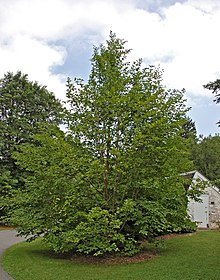
Summary
Stewartia pseudocamellia, also known as Korean stewartia,[2] Japanese stewartia,[3] or deciduous camellia,[4] is a species of flowering plant in the family Theaceae, native to Japan (southern Honshū, Kyūshū, Shikoku) and Korea.
| Stewartia pseudocamellia | |
|---|---|

| |
| Scientific classification | |
| Kingdom: | Plantae |
| Clade: | Tracheophytes |
| Clade: | Angiosperms |
| Clade: | Eudicots |
| Clade: | Asterids |
| Order: | Ericales |
| Family: | Theaceae |
| Genus: | Stewartia |
| Species: | S. pseudocamellia
|
| Binomial name | |
| Stewartia pseudocamellia | |
| Synonyms[1] | |
| |
Names edit
It is called natsutsubaki(ナツツバキ, "summer camellia") in Japanese,[5] and nogaknamu(노각나무, "overripe cucumber tree") in Korean.[6]
The Latin specific epithet pseudocamellia references the flower’s resemblance to the related camellia.[7]
Description edit
It is a small to medium sized deciduous tree, growing to 10–15 m (rarely to 18 m) tall[8][9] often with multiple stems and/or low branching trunks. The bark is smooth textured, exfoliating as the plants age, and has a camouflaged or mottled appearance with patterns of dull orange and green with grey mixed in. The trees are pyramidal to rounded in shape with deep green coloured foliage. Young stems have a zig-zag shape with flattened, divergent buds. The leaves are 4–12 cm long and 2.5–5 cm broad, arranged alternately on the stems with an elliptical shape and finely serrated edges. In the fall the foliage turns yellow, red or purple. The flowers are up to 8 cm wide, with five white petals with orange anthers; they are shaped like those of the related Camellia, round and flat to somewhat cupped. They are produced in summer, generally in June until the end of August; each flower is short-lived, but many are produced that open over many weeks. The fruit is a brown capsule, triangular in shape with four or five angles, persistent on the trees but not showy.[5][6][9]
Varieties edit
There are two varieties:[8][9]
- Stewartia pseudocamellia var. japonica Maxim. Japan. Flowers open cup-shaped.
- Stewartia pseudocamellia var. koreana (Nakai ex Rehd.) Sealy. Korea. Flowers open flat. Often treated as a separate species S. koreana Nakai ex Rehd., mainly in Korea.[6]
Cultivation edit
Stewartia pseudocamellia is an attractive ornamental tree that grows best in rich organic soils with good drainage and consistent moisture throughout the year. It is grown in full sun, but under hot and dry conditions it grows best in some light shade during the afternoon.[10] It is used as a specimen planting in shrub borders or as a specimen in lawn plantings, having year round interest. It can be temperamental to establish and younger trees transplant best.[11] When grown with single trunks they form taller more pyramidal shaped trees, when having multiple trunks plants tend to grow shorter and spread out wider. In the wild in Japan plants have been known to grow 18 m (59 ft) tall, and in cultivation have already reached up to 15 m (49 ft) tall.[12]
S. pseudocamellia was introduced into western cultivation in 1874, and has survived winters as cold as −30 °C (−22 °F).[13]
In the UK this plant,[4][14] and the Koreana Group,[15] have received the Royal Horticultural Society's Award of Garden Merit.
Gallery edit
-
Flower
-
Foliage and fruit
-
Foliage
-
Foliage closeup
-
Foliage and fruit
-
Trunk and distinctive bark
-
Branching from trunk
-
A bud in early spring
References edit
- ^ "Stewartia pseudocamellia Maxim". Plants of the World Online. Board of Trustees of the Royal Botanic Gardens, Kew. 2017. Retrieved 7 September 2020.
- ^ English Names for Korean Native Plants (PDF). Pocheon: Korea National Arboretum. 2015. p. 647. ISBN 978-89-97450-98-5. Archived from the original (PDF) on 25 May 2017. Retrieved 17 December 2016 – via Korea Forest Service.
- ^ "Stewartia pseudocamellia". Germplasm Resources Information Network. Agricultural Research Service, United States Department of Agriculture.
- ^ a b "RHS Plantfinder - Stewartia pseudocamellia". Retrieved 21 November 2018.
- ^ a b (in Japanese)Trees and shrubs of Japan: natsutsubaki.
- ^ a b c (in Korean)Korean Forest Research Institute: Korean Stewartia.
- ^ Harrison, Lorraine (2012). RHS Latin for Gardeners. United Kingdom: Mitchell Beazley. ISBN 978-1845337315.
- ^ a b Bean, W. J. (1980). Trees and Shrubs Hardy in the British Isles 4: 507-513. ISBN 0-7195-2428-8.
- ^ a b c Rushforth, K. (1999). Collins Photographic Guide to Trees. ISBN 0-00-220013-9.
- ^ Dirr's Hardy Trees and Shrubs: An Illustrated Encyclopedia. 1997. ISBN 9780881924046.
- ^ Stewartia pseudocamellia
- ^ Tree Register of the British Isles
- ^ Dirr, M. (1983). Manual of woody landscape plants: their identification, ornamental characteristics, culture, propagation and uses. Champaign, Ill, Stipes Pub. Co.: page 667. ISBN 0-87563-226-2
- ^ "AGM Plants - Ornamental" (PDF). Royal Horticultural Society. July 2017. p. 99. Retrieved 22 November 2018.
- ^ "Stewartia pseudocamellia 'Koreana Group'". RHS. Retrieved 5 March 2021.


